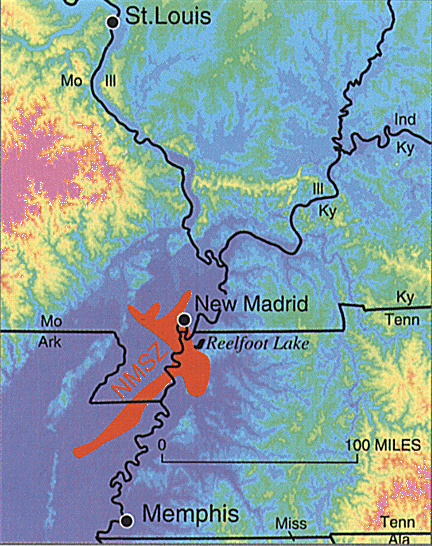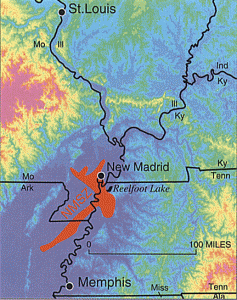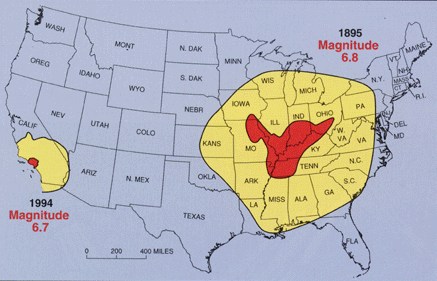Did you feel any shaking or witness any damages or injuries reported via the USGS web-based tool? According to the USGS, there were no reports of damages or injuries from the weak earthquake that rattled southern Illinois last night, not far from the heart of Madrid Seismic Zone.
Generally, earthquakes with a magnitude greater than 2.0 can be felt by most people, and they usually cause much greater intensity. According to the USGS, the earthquake that struck at 5:57 pm was rated as a 2.1 event and had a depth of 7.8 km.
The authorities are concerned that people who are not properly prepared will be greatly affected when this strike occurs. Last night’s earthquake was relatively inconsequential with no reports of damage. The area is more concerned with the possibility of a larger, more destructive earthquake rather than the one that occurred. Although experts say that there is no guarantee it will happen again, the NMSZ has a history of violent earthquakes.

Once again, scientists will emphasize that the 16th of December marks the anniversary of the first major earthquakes to strike the United States during the violent winter of 1811-1812, a significant time in the seismological history of the region.
The ground shook violently for an unbelievably long 1-3 minutes, with the epicenter near Louisville, KY and Nashville, TN. In Boston, the bells of the church rang while Dolly, his wife, and James Madison, the President, felt the quake in the White House. Tens of thousands of feet of air were thrown into the water and dirt as the ground observed liquefaction near the epicenter. Charleston, SC and Washington, DC, along with cities like New York City, felt the earthquake as well. People in the eastern United States felt the shaking, as the earthquake struck the country near the Mississippi River, roughly at 2:15am. This powerful quake, measuring 8.1, rocked the northeast of Arkansas, known for its potent quakes and seismic faults. The West Coast of the US, known for its seismic faults, was also hit hard by the earthquake, which is now known as the New Madrid Seismic Zone.

The “Bootheel” is the area in southeastern Missouri where the seismic zone called New Madrid is located. From December 1811 to March 1812, there were over 2,000 reported earthquakes in the central Midwest, with an estimated 6,000-10,000 earthquakes in total. However, the earthquakes did not end there.
On February 7, 1812, a powerful earthquake measuring 8.8 struck along the Reelfoot fault in Missouri and Tennessee. Several weeks later, on January 23, 1812, Missouri experienced another significant tremor with a magnitude of 7.8, which became the secondary main shock.
The shaking beyond was caused by natural phenomena such as earthquake smog and seismically heated water, as well as earthquake lights in the area. These unusual triggers were also responsible for the quakes. Although the lack of news gathering and scientific tools in that era prevented the full capture of the actual magnitude, intense aftershocks and the main earthquakes created significant loss of life and damage.

The residents in Mississippi’s Valley reported seeing flashing lights coming from the ground. This phenomenon was called “seismoluminescence,” which occurs when light is generated in the ground by quartz crystals. The earthquake lights were triggered during strong aftershocks and primary earthquakes. Scientists hold this belief.
The liquid was additionally abnormally hot, propelled upwards from the earth or the adjacent Mississippi River. The liquid was heated as a result of vigorous shaking and subsequent rubbing, akin to how a microwave oven stimulates particles to vibrate and produce heat, as researchers theorize. Moreover, the liquid was also heated by the emitted illumination from the compressed quartz crystals, as per the beliefs of other scientists.
The regions affected by the earthquake were covered by a humid, dusty haze that formed when dust particles rose from the ground and warm water molecules erupted into the cold winter atmosphere. Experts hypothesize that this phenomenon, known as “earthquake smog,” caused the skies to become so dark during the intense tremors that even lit lamps failed to provide sufficient illumination. Additionally, residents reported unpleasant odors and difficulty breathing due to the poor air quality.
Boaters on the Mississippi River reported that the February earthquake was extremely powerful, causing the water flow there to reverse for a few hours.
In the coming years, there is a possibility of a substantial decrease in human lives and damage to properties when another major earthquake occurs in this location once more. Considering the vast increase in population in the New Madrid Seismic Zone compared to the sparsely inhabited region of the early 1800s, and with tens of millions more people residing in an area that would endure substantial ground shaking, the scientific understanding is not advanced enough to determine if this danger will manifest in the following week or after half a century. Scientists anticipate that the region will be affected by another powerful earthquake at some point, and the area continues to exhibit seismic activity.